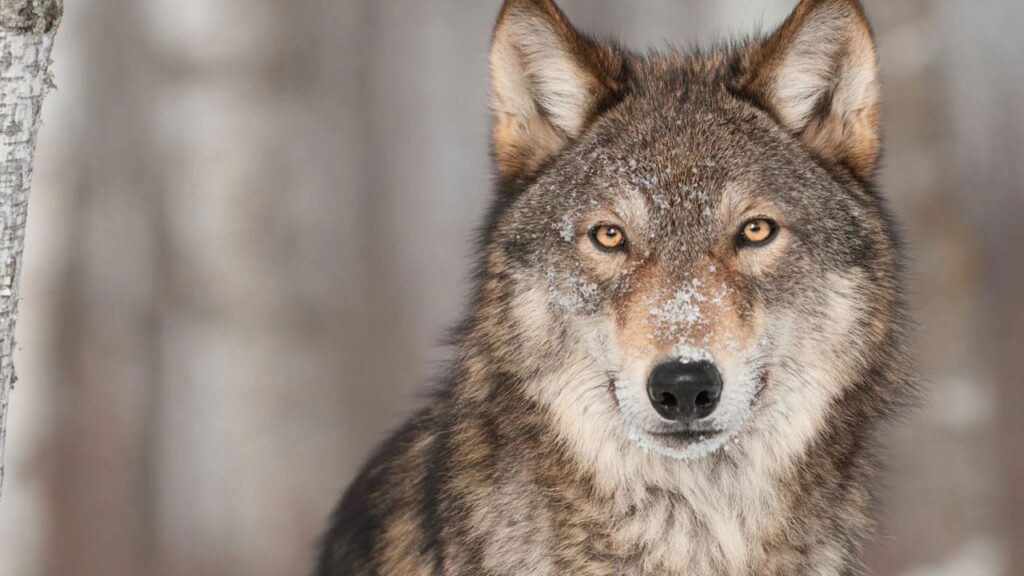Do Grey Wolves Attack Humans? Grey wolves rarely attack humans, with only a few cases reported in the past century.
Grey wolves, known for their piercing howls and enigmatic presence, have long fascinated and frightened people.
From ancient folklore depicting them as menacing predators to modern-day misconceptions, wolves are often cast in a negative light.
Many people wonder if these majestic creatures pose a genuine threat to humans. While wolves are powerful and capable hunters, attacks on humans are exceedingly rare.
In this article, we’ll dive into the behavior of grey wolves, the reasons behind their reputation, and the truth about their interactions with humans.
You’ll gain insight into the life of a grey wolf and learn the steps you can take to safely coexist with these incredible animals.
Contents
What Are Grey Wolves?
Physical Characteristics of Grey Wolves
The grey wolf (Canis lupus) is one of the largest and most widely distributed members of the Canidae family. [Do Grey Wolves Attack Humans?]
Recognizable for their muscular build, sharp teeth, and keen senses, grey wolves are well-suited for life as top predators.
Their coats range in color from grey to white, black, and even red. Their eyes are often amber or pale yellow, contributing to their intense, almost haunting appearance.
Adult grey wolves weigh between 70 and 120 pounds and can stand about 2.5 feet tall at the shoulder, with larger individuals occasionally reaching weights of up to 175 pounds in certain regions.
They have strong legs, a broad chest, and large paws adapted for running, allowing them to travel up to 30 miles per day in search of food.
Habitat and Range
Grey wolves once roamed across vast portions of North America, Europe, and Asia. However, due to human encroachment, hunting, and habitat loss, their numbers have dwindled.
Today, their populations are primarily concentrated in remote, less populated areas. In North America, grey wolves are commonly found in Canada, Alaska, and the northern United States, particularly in places like Montana, Idaho, and Wyoming.
In Europe, they inhabit countries such as Russia, Poland, and parts of Scandinavia. [Do Grey Wolves Attack Humans?]
Wolves can adapt to various environments, including forests, grasslands, deserts, and tundras, although they thrive best in areas where their natural prey is abundant, and human interaction is minimal.

Do Grey Wolves Attack Humans?
Historical Incidents of Wolf Attacks on Humans
Documented cases of grey wolf attacks on humans are extremely rare. Over the past century, there have only been a handful of verified reports.
While such incidents may capture headlines, they are outliers rather than the norm. For instance, between 1900 and 2000, fewer than 100 verified cases of wolves attacking humans were reported worldwide, with even fewer fatalities.
Most documented cases occur when wolves are rabid, injured, or starving—circumstances that can drive abnormal behavior in any wild animal. [Do Grey Wolves Attack Humans?]
Factors That Influence Wolf Attacks
Despite their rarity, certain conditions can contribute to the likelihood of a wolf attack. These include:
- Rabies: Wolves infected with rabies may act aggressively and unpredictably, which increases the risk of an attack. Rabid wolves are often responsible for the rare attacks reported over the past century.
- Food Scarcity: In regions where prey is scarce, wolves may approach human settlements in search of food. Even so, they are more likely to scavenge than to directly confront humans.
- Habitat Encroachment: As human populations expand into wolf territories, the probability of encounters increases. In these cases, wolves may feel threatened or cornered, leading to defensive behavior.
Wolf Behavior Towards Humans
Wolves are naturally skittish around humans. They prefer solitude and generally go out of their way to avoid human contact.
In most cases, wolves will sense a human presence before the human even notices them and will retreat to a safer distance.
Wolves rely on their acute senses of hearing and smell to detect potential threats from afar. [Do Grey Wolves Attack Humans?]
Additionally, wolves tend to avoid humans because of years of learned behavior, as hunting and trapping have made them wary of people.
Comparison to Other Predatory Animals
When compared to predators like bears, mountain lions, and even domestic dogs, wolves are less likely to attack humans.
For example, bear attacks are more common in North America, where bears may become territorial or aggressive if they perceive a human as a threat to their cubs or food supply.
In contrast, wolves view humans as something to avoid rather than confront. Studies show that in the rare instances when wolves do attack, they are usually solitary individuals rather than members of a pack.
Myths and Misconceptions
Wolves have been depicted as dangerous man-eaters in countless stories, from “Little Red Riding Hood” to modern horror films.
However, the reality is quite different. Wolves play a vital role in ecosystems, and their interaction with humans is far less dramatic than pop culture suggests.
Understanding the truth about wolves can help dispel these myths and foster a greater appreciation for these animals.
By learning about wolves’ true nature, people can see them as essential contributors to biodiversity rather than villains.
Why Are Grey Wolf Attacks So Rare?
Natural Avoidance Behavior
Wolves have an inherent caution towards anything unfamiliar, including humans. This behavior is rooted in survival instincts. [Do Grey Wolves Attack Humans?]
When they perceive something as a potential threat, they retreat rather than risk an encounter. This tendency to avoid confrontation is one reason wolf attacks are so rare.
Even when wolves live near humans, they are more likely to scavenge for discarded food or prey on livestock than to attack people directly.
Pack Dynamics and Social Structure
The social structure of a wolf pack minimizes their interest in humans. Packs are led by an alpha pair, with the rest of the members following a strict hierarchy.
Wolves hunt together to take down larger prey, such as deer or elk, which requires cooperation and coordination. Human beings do not fit within their typical prey profile.
The pack’s hunting strategy revolves around animals that provide substantial sustenance, and humans are not only unfamiliar but also do not offer the same nutritional reward.
Human-Wolf Conflict Resolution
Efforts to minimize human-wolf conflict have been underway for decades. Conservationists and government agencies have established programs to reduce encounters between wolves and humans.
For instance, ranchers are encouraged to use non-lethal deterrents, such as guard dogs and fencing, to protect livestock from wolf predation.
Education initiatives also help teach people how to avoid and handle wolf encounters, contributing to safer coexistence. [Do Grey Wolves Attack Humans?]

What To Do If You Encounter a Grey Wolf
Tips for Avoiding an Encounter
- Stay Alert and Make Noise: When hiking in wolf country, make plenty of noise. Wolves have keen senses and are likely to hear you coming, giving them time to avoid you.
- Travel in Groups: Wolves are less likely to approach groups of people, as they perceive larger groups as potential threats. [Do Grey Wolves Attack Humans?]
- Properly Store Food: When camping, store food in bear-proof containers or hang it from a tree to avoid attracting wolves to your campsite.
How to React During an Encounter
If you find yourself face-to-face with a wolf, the most important thing is to remain calm:
- Stand Tall and Make Yourself Big: By spreading your arms or standing on higher ground, you can appear larger and more intimidating.
- Back Away Slowly: Do not turn your back on the wolf, but rather, maintain eye contact (without staring aggressively) and slowly back away.
- Make Noise to Scare the Wolf: If the wolf continues to approach, make loud noises to assert your presence. Clapping your hands, shouting, or using a whistle can deter the wolf.
When to Contact Authorities
Reporting a wolf sighting is essential if you notice unusual or aggressive behavior. [Do Grey Wolves Attack Humans?]
While it is rare, any wolf that appears overly comfortable around humans, especially near populated areas, may need monitoring by wildlife authorities.
Conservation Status of Grey Wolves
Threats to Grey Wolf Populations
Despite their ecological importance, grey wolves face significant threats from human activity.
Habitat destruction due to logging, agriculture, and urban expansion reduces the space wolves have to roam.
Illegal poaching and hunting for sport or protection of livestock also pose dangers to wolf populations.
The loss of wolves from an ecosystem can lead to overpopulation of prey animals, which can, in turn, cause vegetation loss and soil erosion.
This cascade effect emphasizes the critical role wolves play in maintaining a balanced ecosystem. [Do Grey Wolves Attack Humans?]
Conservation Efforts and Reintroduction Programs
Conservation programs have helped reestablish grey wolf populations in areas where they were once eradicated.
For instance, the reintroduction of wolves to Yellowstone National Park in 1995 is one of the most successful examples.
Since their reintroduction, wolves have helped control elk populations, allowing vegetation like willow and aspen to flourish.
This vegetation recovery has brought back species such as beavers and songbirds, showcasing the profound impact wolves have on biodiversity.
Support for these programs is crucial for the ongoing preservation of grey wolves and the ecosystems they inhabit. [Do Grey Wolves Attack Humans?]
Final Verdict
Grey wolves are often misunderstood, with tales of vicious attacks skewing public perception. In truth, wolves are shy animals that prefer solitude over human interaction.
Wolf attacks on humans are incredibly rare, and understanding their behavior helps promote peaceful coexistence.
Wolves play a vital role in ecosystems, helping to regulate prey populations and support the health of their habitats.
By respecting these animals and maintaining a safe distance, we can coexist and contribute to their conservation.
See Also: Do Foxes Attack Humans? The Chilling Truth!
FAQs
Are wolves naturally aggressive towards humans?
No, wolves are naturally cautious around humans and generally avoid them whenever possible. Attacks are extremely rare. [Do Grey Wolves Attack Humans?]
What should I do if I hear wolves howling near me?
Hearing wolves howling doesn’t mean they are close or interested in you. Wolves communicate through howls, often over long distances, to stay connected with their pack.
Are there places where wolf attacks on humans are more common?
No specific place has a high occurrence of wolf attacks. These incidents are rare worldwide and often involve rabid wolves or unusual circumstances.
Can domestic dogs attract wolves to human areas?
Yes, domestic dogs can attract wolves, especially if left outdoors in wolf territories. Wolves may view dogs as competitors or, in some cases, potential mates.
How can I safely observe wolves in the wild?
For safe observation, join a guided wildlife tour where experts can help you enjoy these animals from a safe distance, allowing you to appreciate them without disrupting their natural behavior.
Conclusion: Do Grey Wolves Attack Humans?
The grey wolf, with its strong family ties and critical ecological role, is more than the sum of its misconceptions.
By understanding the truth behind their behavior, we can appreciate these magnificent animals for their contributions to nature.
Educating ourselves and others about wolves helps dispel myths and fosters respect for wildlife, encouraging conservation efforts that protect them and their habitats.
With continued awareness, we can coexist with grey wolves and support the delicate balance of our natural world. [Do Grey Wolves Attack Humans?]

Hello, I am Rosa Ellis, a mother of two and a wildlife blogger. I grew up in New York City, but I love exploring forests. I’ve traveled to places like Yellowstone National Park and the Amazon Rainforest to see animals up close. I know a lot about animal behavior and which animals can be dangerous to humans. Thanks for visiting my blog!

